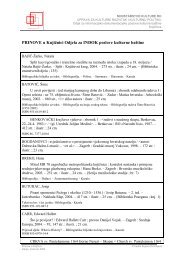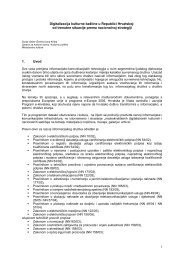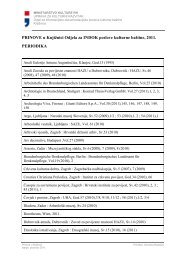Gašpina mlinica u Solinu - Ministarstvo kulture RH
Gašpina mlinica u Solinu - Ministarstvo kulture RH
Gašpina mlinica u Solinu - Ministarstvo kulture RH
Create successful ePaper yourself
Turn your PDF publications into a flip-book with our unique Google optimized e-Paper software.
146 | Godišnjak zaštite spomenika <strong>kulture</strong> Hrvatske 33/34-2009./2010.<br />
foot stepping forward and his right hand raised, in which he carries<br />
a sword, symbolising his martyr’s death. The lower parts of the wall<br />
have revealed the remains of a wall painting depicting scenes of<br />
Hell and the Last Judgment (sl. 16).<br />
Fig. 16 Wall niche with frescoes after restoration work and<br />
presentation<br />
For the protective work required during the renovation of the Church of<br />
St. Luke, a conservationist approach was chosen which would display<br />
the complexity of all the building phases in the architectural history of<br />
the church as a whole. The presentation of medieval, Baroque and Historicist<br />
building structures was achieved in such a way as to emphasise,<br />
during plastering, the textures and ways in which building materials<br />
were used in the different phases of construction.<br />
When the findings of conservation research work were presented,<br />
great attention was devoted to the many engraved sketches on the<br />
cornerstones of this Early Gothic church, as well as various applications<br />
of lime plaster to the facade. These sketches, carved into the stonework,<br />
with their animal and anthropomorphic motifs, are unique to this<br />
medieval church, because they witness through their symbolism to<br />
its turbulent medieval history.<br />
The frontal cornerstones are interesting not only for their artistry, but<br />
also because they document history, and as such, represent architectural<br />
elements which should not be missed while looking around the<br />
church. Since the church inventory was destroyed in a fire, a minimalist<br />
approach has been adopted to renovating the interior, emphasising the<br />
presentation of an Early Gothic wall painting, i.e. the wall niche on the<br />
rear wall of the sanctuary. The Early Gothic wall painting in the wall niche,<br />
depicting an iconographic composition of the church’s patron, St. Luke,<br />
with St. Paul, became the main focus of conservationist presentation<br />
of the interior of this Early Gothic church. Along with the wall painting<br />
on the rear wall of the rectangular sanctuary, the remains of Early Gothic<br />
wall illustrations in the church have also been displayed as a result<br />
of restoration work, including the Late Gothic tabernacle (sl. 17, 18).








